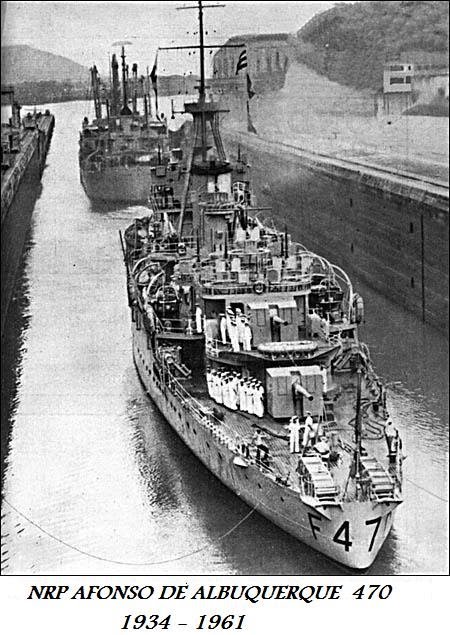 The NRP Afonso de Albuquerque was a warship of the Portuguese Navy, destroyed in combat on 18 December 1961, defending Goa against the Indian Armed Forces invasion. The ship was the first of the Afonso de Albuquerque class, which also included the NRP Bartolomeu Dias.
The NRP Afonso de Albuquerque was a warship of the Portuguese Navy, destroyed in combat on 18 December 1961, defending Goa against the Indian Armed Forces invasion. The ship was the first of the Afonso de Albuquerque class, which also included the NRP Bartolomeu Dias.
These ships were classified, by the Portuguese Navy, as avisos coloniais de 1ª classe (colonial aviso 1st class) and were designed to maintain a Portuguese naval presence in the Overseas territories of Portugal. They had limited capacity to combat other surface vessels, as they were intended, mainly, to support amphibious operations and troops on land. After the Second World War, the Afonso de Albuquerque class ships were reclassified as frigates.
In her career, the NRP Afonso de Albuquerque served, mainly, in the Indian and the Pacific oceans, protecting the Portuguese territories of Mozambique, India, Macau and Timor. In 1945, she was part of the Portuguese Naval and Military Force that regained the Portuguese sovereignty over East Timor, after that territory had been occupied by the Japanese, during the Second World War.
The ship NRP Afonso de Albuquerque was virtually the only military unit with minimal conditions to offer any resistance against the Invasion of Goa state carried out by troops of the Indian Union in December 1961.
Its final combat
In late 1961, the NRP Afonso de Albuquerque was based in Goa as the leading naval unit of the Portuguese India Naval Command, with Captain Cunha Aragão as her commanding officer. After repeated attempts by India to convince Portugal to relinquish its colonies in India failed, an armed conflict was imminent. In the early morning of the 18 December 1961, the Afonso de Albuquerque received information that the Indian Armed Forces had launched Operation Vijay (1961) to invade Goa, Daman and Diu. The crew entered battle stations. As the land communication infrastructure was bombed and destroyed by the Indian Air Force, the Afonso received the responsibility to maintain radio communications between Goa and Lisbon. At 09:00, the Afonso de Albuquerque sighted 3 Indian Navy ships, led by INS Betwa, just outside the Mormugao port. The 2 frigates and a minesweeper were an advance group of an Indian Navy task force which included the aircraft carrier, INS Vikrant and about ten cruisers, destroyers, frigates and minesweepers. At 12:00 noon, as the Portuguese commanders refused to surrender, the Indian frigates INS Betwa and INS Beas forced the entrance into the port, and opened fire on NRP Afonso de Albuquerque. The Afonso moved in the direction of the enemy ships and responded to the fire. At the same time, the final radio message was sent to Lisbon: We are being attacked. We are responding.
However, the Afonso was hit by the enemy fire. At the 12:20 when she tried to manoeuvre to a position in which she could use all its guns, the command bridge of Afonso was hit, killing the radio officer and seriously wounding Captain Cunha Aragão. The captain ordered the first officer to assume command of the ship with instructions not to surrender. Under heavy fire directed at the ship, some of the crew evacuated the injured commander to the shore, and transferred him by car to medical facilities at Panjim. At 12:35, under massive fire and, already, with the boilers and the machines destroyed, the Afonso crew ran it aground onto the beach to be used as a fixed battery. The crew continued to resist and fight until about the 13:10, after which they surrendered. The crew was then taken prisoner by Indian. During her last combat, it is estimated that the NRP Afonso de Albuquerque fired almost 400 shells. 5 of her crew died, and 13 crewmen, as well as some officers, were injured. The advantage of the enemy was significant, as their ships were more modern and armed with quick firing guns. The Afonso lay grounded at the beach near Dona Paula, until 1962 when it was towed to Bombay.
The ship was renamed Saravastri by Indians.
Parts of the ship were recovered and are on display at the Naval Museum in Bombay. The remainder of the ship was sold as scrap.

No comments:
Post a Comment